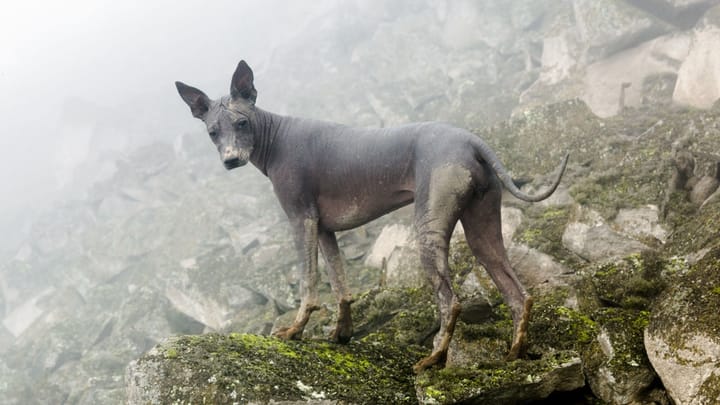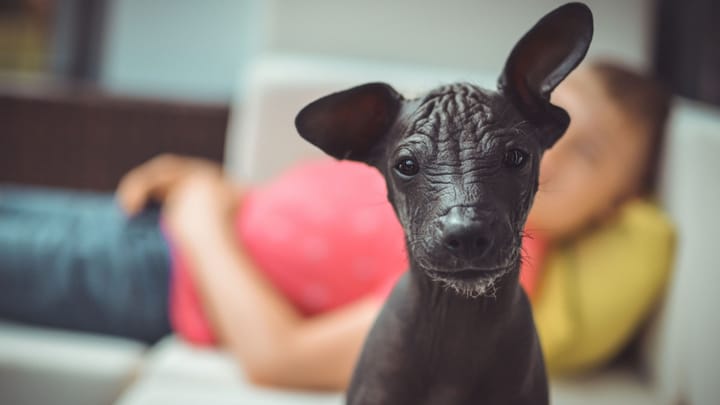Peruvian Hairless Dog
Other names : Peruvian Inca Orchid, Perro Sin Pelo de Peru, Inca Hairless Dog, Viringo, Calato, Peruvian Walking Dead Dog, Dielmatian


The Peruvian Inca Orchid is a hairless dog that comes in three different sizes: small, medium, and large. Also known as the Peruvian Hairless dog, it’s roots can be traced as far back as 750AD. They were actually used as a food source for tribes around the coastal region of Peru. However, the Incas put a stop to this practice after conquering the area. The Peruvian Inca is a lively little character. They’re very affectionate towards their owners and don’t like being left alone for long periods of time.
|
Life expectancy |
The Peruvian Hairless Dog has a life expectancy of between 10 and 12 years |
|
Temperament |
|
|
Size |
Medium
|
|
Adult size |
Female
Between 10 and 26 in
Male
Between 10 and 26 in
|
|
Adult weight |
Female
Between 9 and 66 lb
Male
Between 9 and 66 lb
|
|
Coat colour
Black. White. Grey. Brown. Can be one colour or with pink spots. |
Black Brown Blue |
|
Type of coat
Hairless. |
Naked Very short |
|
Eye colour
Brown. |
Brown
|
|
Purchase price |
The Peruvian Hairless Dog costs between £1500 and £2500 |
Almost all Peruvian Incas are hairless. However, a small number have a short, tight coat.
The gene that causes hairlessness also causes some dental problems. Peruvian Incas have fewer teeth than other breeds. They also tend to fall out as the Inca approaches old age.
Although they don’t require any grooming, many experts recommend using a moisturising lotion to help keep the Incas skin clean and healthy. But opt for natural, organic options like olive oil, coconut oil, and baby lotion that DOES NOT contain lanolin.
More details about the Peruvian Hairless Dog
Peruvian Hairless Dog: Origins and history
The Peruvian Inca dog was revered by many ancient tribes. Depictions of the dog appear on artefacts dating from 300BC. They are seen on the ceramics from pre-Inca tribes like the Vicus, the Mochica, the Chancay, and the Chimu. Despite holding the animal in high regard, some of these tribes used it as a food source, although the Incas put an end to the practice when they conquered the region. The Inca believed that this small, hairless animal had mystical qualities, including the ability to heal serious medical conditions. It wasn't recognised by the FCI until 1985.
Physical characteristics of the Peruvian Hairless Dog
Hairless. A slim and elegant frame. Long but muscular neck. High head carriage. Erect ears and a medium length tail which is also very thin. Alert posture.
FCI classification of the Peruvian Hairless Dog
-
Group 5 - Spitz and primitive types
-
Section 6 : Primitive type
Peruvian Hairless Dog: Characteristics
Peruvian Hairless Dog: Behaviour
Training a Peruvian Hairless Dog
In the right hands, these dogs are fairly easy to train. But they do require a varied and challenging training schedule.
Peruvian Hairless Dog: Lifestyle
Breed compatibility Peruvian Hairless Dog
Peruvian Hairless Dog: Purchase price
The cost of buying a Peruvian Inca puppy will be between £1500 to £2500. Monthly costs will be between £50 to £80.
Peruvian Hairless Dog: Shedding
None
Hairless.
Peruvian Hairless Dog: Grooming
Extremely low grooming needs. Need to be bathed and oiled routinely to avoid skin problems.
Peruvian Hairless Dog: Health
Generally healthy, although they do have some breed specific problems. Their average life expectancy is 10 to 12 years.
A small but sturdy animal. Well built. Muscular. Smaller Peruvian Incas are a bit more delicate.
Unlikely to overheat, but overexposure to direct sunlight can lead to sunburn and skin lesions.
These hairless dogs will suffer in the cold. They will need a thick doggy coat for winter walks. Not suited for owners living in colder climates.
No issues with weight gain or obesity.
- Dental issues
- Skin lesions
- Skin infections
- Irritable Bowel Syndrome
- Seizures
- Strokes






